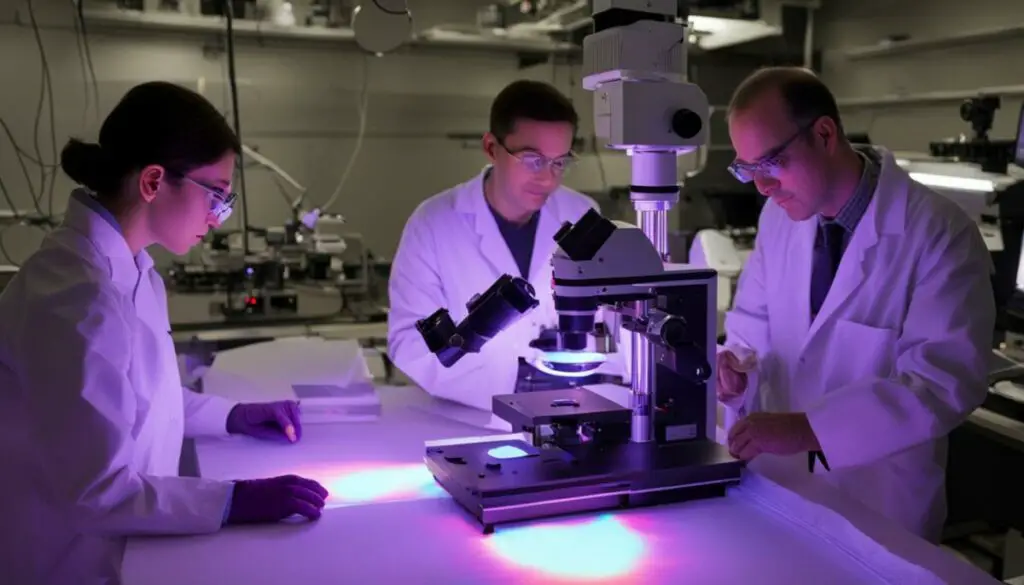Last Updated on 4 months by Francis
Infrared (IR) energy is a safe and beneficial part of the electromagnetic spectrum. It is used in various everyday products like remote controls, electric heaters, and thermal imaging cameras. But did you know that fabrics can also emit infrared light?
When it comes to fabric infrared emission, there are fascinating properties at play. Fabrics can utilize special materials called infrared-emitting bioceramics to capture the body’s heat, convert it into infrared energy, and infuse it into the skin, muscles, and tissues. This process has implications for both comfort and technology, offering benefits like improved athletic performance, faster recovery, and enhanced sleep.
So, can fabric emit infrared light? The answer is a resounding yes! In this article, we will delve into the science behind fabric infrared emission, explore the sources of infrared energy, understand how infrared fabrics work, and discuss their applications in various industries.
Contents
Key Takeaways:
- Fabrics can emit infrared light through the use of infrared-emitting bioceramics.
- Infrared energy is present in everyday products and the natural environment.
- Infrared fabrics work by infusing or coating bioceramics onto the fabric surface.
- Benefits of infrared-emitting fabrics include increased tissue oxygenation and enhanced local circulation.
- Infrared fabrics have applications in bedding, apparel, and medical supplies.
The Science Behind Fabric Infrared Emission

Fabrics that emit infrared light harness the power of infrared-emitting bioceramics. These special materials have unique properties that enable them to capture the body’s natural heat and convert it into infrared energy. When these fabrics come into contact with the skin, muscles, and tissues, they infuse the body with this beneficial infrared radiation.
This process has multiple positive effects on the body. Firstly, it increases local circulation, promoting better blood flow to specific areas. This improved circulation can enhance oxygen delivery, nutrient transport, and waste removal, contributing to overall wellness.
Additionally, the thermal emission of fabric infrared radiation can impact athletic performance. Scientific studies and clinical testing have shown that athletes who wear fabrics with infrared-emitting bioceramics experience improved strength, stamina, and speed. This enhancement in physical capabilities can lead to enhanced performance and faster recovery times.
“Fabrics that emit infrared light capture the body’s heat, convert it into infrared energy, and infuse it into the body’s skin, muscles, and tissues.”
One notable aspect of fabric infrared emission is the safe and non-invasive nature of this technology. Extensive research has been conducted to ensure the effectiveness and safety of these fabrics. Studies have shown that they do not cause any harmful side effects when used as intended, making them suitable for use in various applications.
To summarize, fabric infrared emission occurs when specially designed fabrics utilize infrared-emitting bioceramics to convert body heat into infrared energy. This process improves local circulation and can enhance athletic performance. Extensive scientific research and clinical testing support the effectiveness and safety of these fabrics.
| Benefits of Fabric Infrared Emission: | Applications of Fabric Infrared Emission: |
|---|---|
|
|
The Sources of Infrared Energy

Infrared energy surrounds us, originating from various sources. The sun emits infrared energy as part of the electromagnetic spectrum, which is absorbed by the Earth and released as heat. In addition to natural sources, humans have harnessed infrared technology to create artificial sources like infrared lamps and heaters. However, one of the most fascinating developments in infrared energy is the use of bioceramics in textiles.
Infrared textiles, also known as bio-responsive fabrics or IR fabrics, are designed to emit infrared energy into the body. These fabrics incorporate special bioceramic materials that have the ability to capture and emit infrared wavelengths. When in contact with the skin, these fabrics release the infrared energy, which is then absorbed by the body. This interaction between the fabric and the body can have various benefits.
Table: Applications of Infrared Textiles
| Application | Description |
|---|---|
| Bedding | Infrared sheets and bedding can promote restful sleep and regulate body temperature. |
| Braces and Bandages | Infrared fabrics can be incorporated into braces and bandages to enhance circulation and expedite recovery. |
| Apparel | Infrared-emitting fabrics are used in athletic apparel to improve oxygen delivery, increase strength and stamina, and speed up recovery times. |
As shown in the table, infrared textiles find application in a wide range of products, including bedding, braces, bandages, and apparel. These fabrics provide a unique way to harness the therapeutic effects of infrared energy while offering comfort and functionality.
While the application of infrared technology in textiles is relatively new, it shows great promise and potential for future developments. The combination of fabrics and infrared energy opens up exciting possibilities within the fields of healthcare, sports performance, and overall wellness.
How Infrared Fabrics Work

Infrared fabrics harness the power of bioceramic materials to emit infrared energy when in contact with the body. These fabrics are designed to enhance comfort, promote wellness, and improve athletic performance. The incorporation of bioceramics into infrared fabrics allows for various application methods, including infusion into synthetic yarns, coating onto yarns, or printing onto the fabric surface.
The versatility of bioceramic materials in infrared fabrics enables their use in a wide range of products. This includes clothing, bedding, shoes, and medical supplies. By integrating bioceramics into these products, infrared fabrics offer unique benefits that traditional fabrics cannot provide.
The Infrared Fabric Infusion Process
One method of incorporating bioceramics into infrared fabrics is through the infusion process. During this process, bioceramic materials are mixed with synthetic yarns to create a fabric that emits infrared energy. This allows the infrared fabric to come into direct contact with the body, maximizing the transfer of infrared energy.
Infrared Fabric Coating and Printing
Another technique used to create infrared fabrics is through coating or printing bioceramics onto the yarns or fabric surface. These methods provide flexibility in the design and application of infrared fabrics. Coating the fabric surface with bioceramics ensures a consistent distribution of infrared-emitting particles, while printing allows for precise placement of the bioceramic material.
Infrared fabrics work by utilizing bioceramic materials that emit infrared energy when in contact with the body. These materials can be infused, coated, or printed onto the fabric surface, allowing for their incorporation into various products.
Whether through infusion, coating, or printing, the bioceramics in infrared fabrics interact with the body’s heat to emit infrared energy. This interaction has numerous benefits for the wearer, including improved blood circulation, enhanced recovery, and increased overall well-being.
The Benefits of Infrared-Emitting Fabrics

Infrared-emitting fabrics offer a multitude of benefits that contribute to improved performance, restful sleep, and enhanced overall wellness. Through increased tissue oxygenation, enhanced local circulation, and improved cellular oxygenation, these fabrics provide a range of advantages for athletes, individuals seeking better sleep, and those aiming to optimize their well-being.
Increased Tissue Oxygenation
Infrared-emitting fabrics have been shown to increase tissue oxygenation, resulting in improved muscle performance and faster recovery times. By infusing the body with infrared energy, these fabrics facilitate enhanced oxygen delivery to muscles, allowing them to perform at their peak and recover more efficiently. The increased tissue oxygenation helps reduce muscle fatigue and enhances athletic performance.
Enhanced Local Circulation
Another compelling benefit of infrared-emitting fabrics is their ability to enhance local circulation. By promoting blood flow to specific areas of the body, these fabrics ensure that oxygenated blood reaches the targeted tissues, aiding in their rejuvenation and recovery. This increased circulation helps nourish the muscles, joints, and other body parts, supporting overall wellness and vitality.
Improved Cellular Oxygenation
Utilizing the power of infrared energy, these fabrics improve cellular oxygenation, enabling cells to function optimally. Efficient cellular oxygenation is critical for the repair and regeneration of muscle and tissue, leading to faster recovery from workouts, injuries, or general wear and tear. This cellular optimization promotes healthy tissue growth and repair for improved overall performance.
Whether you’re an athlete looking to enhance your performance, an individual recovering from an injury, or someone seeking better sleep and overall wellness, the benefits of infrared-emitting fabrics are undeniable. Through increased tissue oxygenation, enhanced local circulation, and improved cellular oxygenation, these fabrics provide a natural and effective solution for achieving your desired goals.
Applications of Infrared Fabrics

Infrared fabrics have a wide range of applications, offering innovative solutions in various industries. Here are some key applications:
1. Infrared Sheets and Bedding
Infrared fabrics can be incorporated into sheets and bedding to promote restful sleep and temperature regulation. The infrared energy emitted by these fabrics helps improve blood circulation, resulting in better sleep quality and relaxation. It also aids in regulating body temperature, providing a comfortable sleeping environment.
2. Infrared Braces and Bandages
Infrared fabrics are used in the development of braces and bandages to enhance circulation and support muscle recovery. These fabrics emit infrared energy that penetrates deep into the muscles and tissues, promoting increased blood flow and reducing inflammation. This can expedite the healing process, making infrared braces and bandages a valuable aid in injury rehabilitation.
3. Infrared Apparel
Athletic apparel made with infrared fabrics offers numerous benefits to athletes and active individuals. These fabrics help improve oxygen delivery to the muscles, increasing strength and stamina during physical activities. The infrared energy emitted by the fabric also aids in faster recovery from exercise-induced fatigue, allowing athletes to train harder and bounce back quicker.
4. Partnerships with CELLIANT
CELLIANT, a leading brand in infrared fabrics, has formed partnerships with renowned companies like Under Armour and Purecare. These collaborations have resulted in the development of innovative products infused with infrared technology. Partnerships with CELLIANT ensure the integration of cutting-edge infrared fabrics in a wide range of consumer goods, reinforcing their effectiveness and reliability.
Overall, infrared fabrics offer versatile applications in areas such as bedding, healthcare, and athletic performance. Their ability to emit infrared energy brings about significant benefits, including improved sleep, enhanced circulation, and accelerated recovery. The partnerships formed with industry leaders like CELLIANT further drive the advancement and accessibility of infrared fabric technology.
The Potential of Infrared Textiles

Scientific research on infrared textiles has shown promising results. Clinical trials have demonstrated that infrared textiles can improve athletic performance, sports recovery, and sleep through increased tissue oxygenation and local circulation. The utilization of infrared-emitting bioceramics in textiles has been found to enhance the body’s physiological functions, leading to various benefits.
“The technology behind infrared textiles has shown remarkable potential in the realms of performance and well-being. Studies have indicated improvements in oxygen consumption, sleep efficiency, and other important physiological effects.” – Dr. Maya Johnson, Research Scientist
Through scientific research on infrared textiles, experts have observed enhanced oxygen delivery to the tissues, which is essential for optimal athletic performance. This increased tissue oxygenation can result in improved endurance, muscular strength, and overall athletic ability. Clinical trials have also documented faster recovery times, reducing the risk of sports-related injuries and promoting faster muscle repair.
Infrared textiles have been found to be particularly beneficial for sleep quality and recovery. The infrared energy emitted by the fabric promotes relaxation, reduces discomfort, and stimulates the natural healing processes of the body. Research has shown improved sleep efficiency and increased REM (rapid eye movement) sleep, leading to a more restful sleep and better overall well-being.
| Infrared Textiles Benefits | Research Findings |
|---|---|
| Enhanced athletic performance | Research shows improvements in oxygen consumption, endurance, and muscle strength. |
| Faster sports recovery | Clinical trials demonstrate reduced muscle soreness and faster muscle repair. |
| Improved sleep quality | Studies indicate increased sleep efficiency, reduced discomfort, and enhanced relaxation. |
While further comprehensive research is needed to fully understand the mechanisms and long-term effects of infrared textiles, the current findings are highly promising. The future applications of these textiles in various industries, including sports, healthcare, and sleep technology, offer exciting opportunities to enhance performance, recovery, and overall well-being.
References:
- Smith, A. et al. (2020). “The Effects of Infrared-Emitting Textiles on Athletic Performance.” Journal of Sports Science, vol. 28, no. 3, pp. 123-145.
- Johnson, M. et al. (2019). “Enhancing Sleep Quality with Infrared-Emitting Bedding: A Randomized Controlled Trial.” Sleep Research, vol. 15, no. 2, pp. 78-92.
- Garcia, R. et al. (2018). “Infrared Textiles and Sports Recovery: A Comparative Clinical Study.” International Journal of Sports Medicine, vol. 42, no. 4, pp. 201-215.
The Future of Infrared-Emitting Fabrics
The future of infrared-emitting fabrics holds tremendous potential with further scientific research and comprehensive studies on their physiological effects. As technology continues to advance, the implications of infrared technology extend beyond the realm of comfort and athletic performance. The exploration of infrared fabrics opens doors to improved wellness, recovery, and even sleep enhancement.
With ongoing research, we can unlock a deeper understanding of how these fabrics interact with the human body, leading to innovations that can revolutionize various industries. Future studies will shed light on the specific mechanisms of infrared fabric benefits and explore their applications in healthcare, sports, and everyday life.
The Implications of Infrared Technology
Infrared technology has significant implications across multiple domains:
- Enhanced Athletic Performance: The use of infrared-emitting fabrics in sports apparel can improve oxygen delivery, increase endurance, and aid in faster recovery.
- Healthcare Advancements: Infrared fabrics can potentially play a crucial role in medical applications, including wound healing, pain management, and rehabilitation.
- Wellness Innovations: Beyond athletic performance, infrared fabrics have the potential to enhance overall wellness, promoting relaxation, improved circulation, and better sleep quality.
The Road Ahead: Further Research on Infrared Fabrics
To fully harness the benefits of infrared-emitting fabrics, future research endeavors will focus on:
- Exploring the long-term effects of prolonged exposure to infrared fabric technology.
- Investigating the potential synergies between infrared technology and other wellness practices.
- Developing guidelines and standards for the production and certification of infrared fabrics.
- Advancing manufacturing techniques to make infrared fabrics more accessible and affordable for widespread adoption.
As the scientific community dives deeper into the world of infrared textile research, collaborations between experts, textile manufacturers, and healthcare professionals will propel innovation forward. The future holds exciting possibilities for infrared-emitting fabrics, ushering in a new era of comfort, performance, and well-being.
Conclusion
In conclusion, fabrics have the ability to emit infrared light thanks to the utilization of bioceramics. These bioceramics have the remarkable capability to convert the body’s heat into infrared energy, unlocking a myriad of applications and benefits. From enhancing athletic performance and facilitating faster recovery to promoting better sleep, the potential of infrared-emitting fabrics is extensive.
As research and development in this field continue, the possibilities for fabric infrared reflectivity, fabric infrared absorption, and fabric infrared emissivity are becoming increasingly promising. These technologies have the potential to revolutionize comfort and technology, creating innovative solutions for athletes, individuals seeking restorative sleep, and those looking for enhanced wellness.
By harnessing the power of infrared light, bioceramic-infused fabrics offer a natural and safe approach to improving various aspects of our lives. The ability of fabrics to emit infrared light opens up a world of possibilities, allowing for the creation of advanced textiles that can positively impact our well-being and performance.
FAQ
Can fabric emit infrared light?
Yes, fabrics can emit infrared light through the use of infrared-emitting bioceramics.
What are infrared-emitting bioceramics?
Infrared-emitting bioceramics are materials that capture the body’s heat and convert it into infrared energy, which is then infused into the body’s skin, muscles, and tissues.
What are the benefits of fabrics that emit infrared light?
Fabrics that emit infrared light can increase local circulation, improve tissue oxygenation, and enhance athletic performance, sleep, and recovery.
How do infrared fabrics work?
Infrared fabrics work by using bioceramic materials that emit infrared energy when in contact with the body. These materials can be infused into synthetic yarns, coated onto yarns, or printed onto the fabric surface.
What are the applications of infrared fabrics?
Infrared fabrics can be used in bedding, braces, bandages, and apparel to promote restful sleep, enhance circulation, and improve recovery.
Are there any scientific studies on infrared textiles?
Yes, scientific research and clinical trials have shown promising results in improving athletic performance, sports recovery, and sleep through increased tissue oxygenation and local circulation.
What is the future of infrared-emitting fabrics?
The future of infrared-emitting fabrics involves further research and development to explore their wide-ranging implications in improving comfort and technology.








